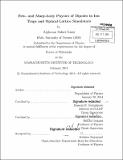Few- and many-body physics of dipoles in ion traps and optical lattice simulators
Author(s)
Safavi-Naini, Arghavan
DownloadFull printable version (17.06Mb)
Other Contributors
Massachusetts Institute of Technology. Department of Physics.
Advisor
Hossein R. Sadeghpour and Senthil Todadri.
Terms of use
Metadata
Show full item recordAbstract
The presence of strong interactions in quantum many-body systems makes the analytical treatment of such systems very difficult. In this thesis we explore two possible proposals for simulating strongly correlated, quantum many-body systems: quantum simulations using trapped-ion quantum computers, and optical lattice simulators. In the first part of the thesis we describe the recent advances in Quantum Information Processing. In particular, we focus on the trapped-ion quantum computer. One of the main experimental roadblocks for this architecture is the "anomalous heating". This refers to the motional heating of the ion after being cooled to its ground state. In this thesis we present the first ab-initio and microscopic model for this noise. This model attributes the noise to fluctuating dipoles formed by adsorbates bound on the trap surface. The second part of the thesis studies three different lattice boson systems. First, we study the Bose-Hubbard model for hard-core bosons, interacting via dipole-dipole interactions. The resulting extended Bose-Hubbard model can be experimentally realized by polar molecules, Rydberg atoms, or magnetic dipoles in optical lattices. We use quantum Monte Carlo simulations, using the two-worm algorithm to study the ground-state phase diagram of dipolar, hard-core bosons, trapped in a bilayer geometry. Each layer is a quasi two-dimensional lattice, the dipole are aligned perpendicular to the layer, and inter-layer hopping is suppressed. We present zero- and finite-temperature results. Next we use a novel multiworm algorithm, along with bosonization, to study the ground-state phase diagram of bosons trapped in a stack of one-dimensional tubes. We study two different inter-particle interactions. First, we consider nearest-neighbor attractive interactions between the layers, and set the intra-layer interactions to zero. Next we study dipolar bosons with their dipole moments aligned perpendicular to the tube axis. Inter-layer tunneling is suppressed in both cases. Finally, we explore the possibility of using few-body phenomena to create exotic quantum many-body systems. We present a novel scheme to realize a tunable, onsite, three-body interaction. We study the resulting extended Bose-Hubbard model with a three-body on-site term using the Gutzwiller mean-field method, as well as quantum Monte Carlo simulations using the Worm algorithm.
Description
Thesis: Ph. D., Massachusetts Institute of Technology, Department of Physics, 2014. Cataloged from PDF version of thesis. Includes bibliographical references (pages 219-229).
Date issued
2014Department
Massachusetts Institute of Technology. Department of PhysicsPublisher
Massachusetts Institute of Technology
Keywords
Physics.